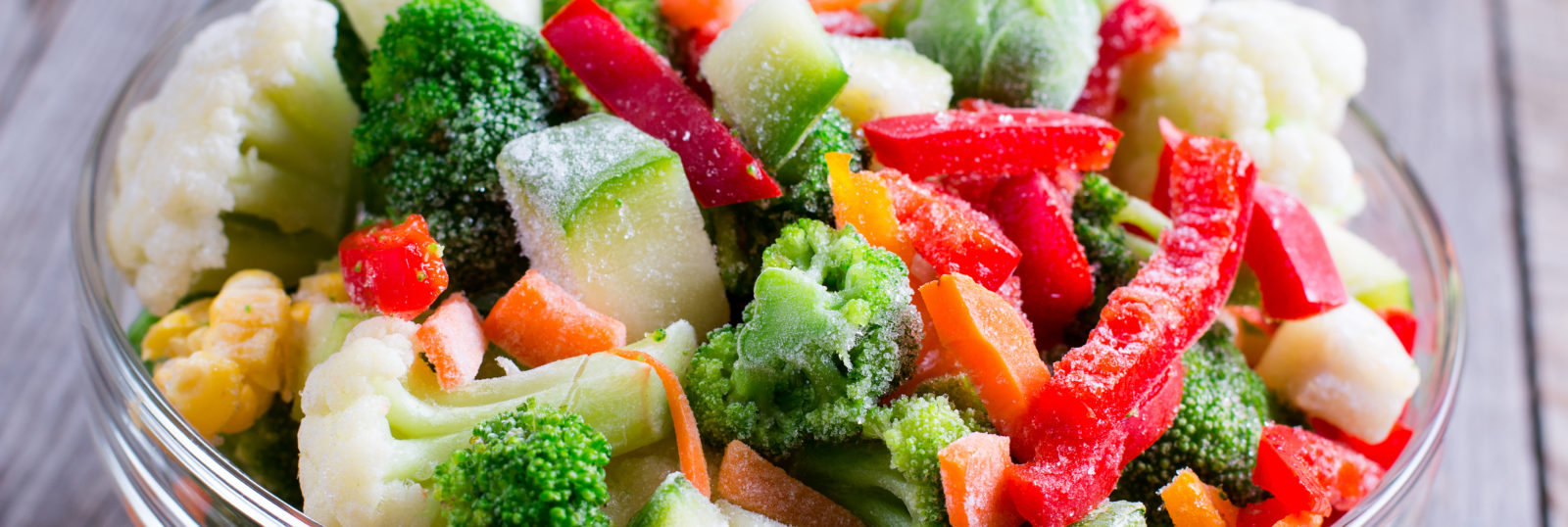During the glorious spring, summer, and autumn seasons, you can find all sorts of fresh, local produce at the grocery store, farmer’s markets, or your CSA. During the dead of winter, however, most of the produce you find on supermarket shelves is imported, which means it is less tasty and more expensive. The cold, snowy months make it an excellent time to take advantage of frozen vegetables.
There are many benefits to frozen vegetables. They are picked at their peak of ripeness, then blanched to destroy bacteria and stop enzymatic activity (that could spoil it), and finally, flash frozen to preserve its nutrients.
In fact, frozen veggies may be arguably more nutritional than their fresh counterparts, especially in the winter, when “fresh” veggies travel hundreds of miles before reaching your grocery shelf. Spinach, for instance, loses roughly half its folate content after just eight days after being picked.
A British study compared nutrient levels in frozen produce against their equivalents that had been sitting in a fridge for three days and found more beneficial nutrients overall in the frozen samples. In two out of three samples, frozen fruits and veggies had higher levels of antioxidants, including polyphenols, anthocyanins, lutein, and beta carotene.1 This supports previous research that freezing can “lock in” nutrients rather than destroying them. In one report, the vitamin C in fresh broccoli diminished by more than 50 percent in a week but only 10 percent when frozen for an entire year.2
United States Department of Agriculture (USDA) has three levels of grading shields for frozen vegetables: U.S. Grade A or “U.S. Fancy”; Grade B or “U.S. Choice” or “Extra Standard”; Grade C or “U.S. Standard.” When possible, purchase Grade A or “U.S. Fancy,” as they will be the most tender, delicious, and uniform for shape and color, which also lends to the most even cooking. Note, though, that since grading is voluntary, not every bag of veggies will be labeled.
By stark contrast, frozen vegetables are far nutritionally superior to canned alternatives. Not only does the canning process diminish nutritional value (exceptions are canned pumpkin and tomatoes), but it also usually adds unnecessary sugar and salt, too.
And those small bags of “steam-ready” veggies aside, frozen veggies are also cheap, virtually prep-free, and won’t go bad if you forget about them!
If you haven’t taken a stroll down the frozen veggie aisle in a while, winter is the time. It offers so much more than just peas and carrots. You can find cauliflower florets, artichokes, chard, kale blends, and pureed butternut squash. I frequently use the latter in mac and cheese, just add at the same time as the butter and cheese to add a dose of undetectable vitamin A to a kid favorite.
How to Use
When and how to thaw can vary depending on the recipe, but there is one golden rule: do not boil. Boiling frozen vegetables will only add moisture, which will make your veggies mushy. Boiling will also leech out water-soluble vitamins like Bs and C. A good rule of thumb is to steam.
For some recipes, thawing isn’t necessary. One foolproof way to use frozen vegetables is in soups or stews—minestrone and chicken soup are two favorites. Simply add them toward the end of the cooking time, just long enough to warm them but not enough to turn them into mush. Frozen vegetables can easily be incorporated into baked items like frittatas, lasagna, muffins, or savory pie fillings, without having to thaw or pre-cook them first.
Season them up! They can be enjoyed on their own; simply defrost and season with olive oil, garlic, and fresh herbs, and mix with quinoa or brown rice. Try tossing with pesto: broccoli with sundried tomato pesto or spinach with roasted red pepper pesto are two delightful combinations.
Stir-fries are another great way to incorporate frozen vegetables. After sautéeing your protein (chicken, beef, or shrimp), add your frozen veggies to the wok for a few minutes before adding your sauce. If tofu is more your thing, you can add your veggies at the same time you toss in your tofu. (Check out our Winter Chicken and Frozen Vegetable stir-fry.) Serve over riced cauliflower (also in the frozen vegetable section!) or brown rice and your quick, wintry dinner is done!
Reference:
- http://www.tuco.ac.uk/images/zoo/uploads/documents/RD_Antioxidant_levels_in_frozen_produce.pdf
- http://abcnews.go.com/Health/reasons-buy-frozen-fruits-veggies/story?id=20683879#2

